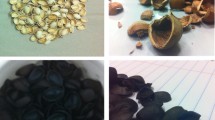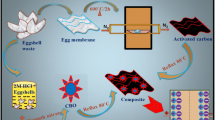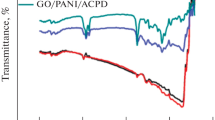Abstract
In this work, comparative studies on the activated carbons (ACs), derived from of Sabal palmetto and Pterospermum acerifolium trees, are presented for electric double-layer capacitor (EDLC) application. The objective of this work is to obtain ACs from a novel biomass using a cost-effective synthesis approach. In this work, we have used Sabal palmetto and Pterospermum acerifolium leaves (dead leaves) as precursors for ACs for the first time. Both dead leaves and fresh precursors are available in huge amounts. In order to reduce the production cost, no specific gaseous environment is used during any synthesis step. The obtained ACs are found to show respectably high surface area and porosity. The respective ACs were synthesized in a cost-effective way via carbonization of the leaves followed by chemical activation with ZnCl2 and thermal activation at ambient conditions. The structural and morphological studies were done using X-ray diffraction (XRD), scanning electron microscope (SEM), and Brunauer–Emmett–Teller (BET) techniques. The electrochemical performance of the ACs, as electrodes in EDLC, was studied by using cyclic voltammetry (CV), galvanostatic charge–discharge (GCD), and electrochemical impedance spectroscopy (EIS). The Sabal palmetto (SP) and Pterospermum acerifolium (PA) based nanostructured ACs display high specific surface area of 971 m2 g−1 and 1151 m2 g−1 and crystallite size of ~ 47.45 nm and ~ 67.83 nm respectively. The Sabal palmetto–derived AC possesses higher value of mesopore/micropore volume ratio (Vmeso/Vmicro) as ~ 0.89 than that of derived from Pterospermum acerifolium (Vmeso/Vmicro ~ 0.64). The EDLC fabricated using Sabal palmetto–derived AC delivers specific capacitance of 90.98 F g−1, which is about twice of Pterospermum acerifolium–derived activated carbon. The EDLC utilizing the Sabal palmetto–derived AC demonstrates superior capacity retention of 98.7% after 10,000 charge–discharge cycles.











Similar content being viewed by others
Data availability
The data used to support the findings of this study are included within the article.
References
Bergna D, Varila T, Romar H, Lassi U (2018) Comparison of the properties of activated carbons produced in one-stage and two-stage processes. C-Journal of Carbon research 4:41. https://doi.org/10.3390/c4030041
Samantara AK, Ratha S (2018) Historical background and present status of the supercapacitors. In: Samantara AK, Ratha S (eds) Materials development for active/passive components of a supercapacitor: background, present status and future perspective. Springer, Singapore, pp 9–10
Singh Syali M, Mishra K, Kanchan DK, Kumar D (2021) Studies on a novel Na+ superionic conducting polymer gel cocktail electrolyte membrane immobilizing molecular liquid mixture of carbonates, tetraglyme and ionic liquid. J Mol Liq 341:116922. https://doi.org/10.1016/j.molliq.2021.116922
Şahin Ö, Yardim Y, Baytar O, Saka C (2020) Enhanced electrochemical double-layer capacitive performance with CO2 plasma treatment on activated carbon prepared from pyrolysis of pistachio shells. Int J Hydrog Energy 45:8843–8852. https://doi.org/10.1016/j.ijhydene.2020.01.128
Kumar D, Yadav N, Mishra K et al (2022) Sodium ion conducting flame-retardant gel polymer electrolyte for sodium batteries and electric double layer capacitors (EDLCs). J Energy Storage 46:103899. https://doi.org/10.1016/j.est.2021.103899
Kumar Y, Gupta A, Thakur AK et al (2021) Advancement and current scenario of engineering and design in transparent supercapacitors: electrodes and electrolyte. J Nanoparticle Res 23:1–15. https://doi.org/10.1007/s11051-021-05221-5
Enock TK, King’ondu CK, Pogrebnoi A, Jande YAC (2017) Status of biomass derived carbon materials for supercapacitor application. Int J Electrochem 2017:e6453420. https://doi.org/10.1155/2017/6453420
Sudiana IN, Mitsudo S, Firihu MZ et al (2017) Investigation of silica from rice husk ash wastes as an alternative material for microwave absorbers. AIP Conf Proc 1801:040003. https://doi.org/10.1063/1.4973092
Gratuito MKB, Panyathanmaporn T, Chumnanklang R-A et al (2008) Production of activated carbon from coconut shell: optimization using response surface methodology. Bioresour Technol 99:4887–4895. https://doi.org/10.1016/j.biortech.2007.09.042
Le Van K, Luong Thi TT (2014) Activated carbon derived from rice husk by NaOH activation and its application in supercapacitor. Prog Nat Sci Mater Int 24:191–198. https://doi.org/10.1016/j.pnsc.2014.05.012
Fujishige M, Yoshida I, Toya Y et al (2017) Preparation of activated carbon from bamboo-cellulose fiber and its use for EDLC electrode material. J Environ Chem Eng 5:1801–1808. https://doi.org/10.1016/j.jece.2017.03.011
Bediako JK, Lin S, Sarkar AK et al (2020) Evaluation of orange peel-derived activated carbons for treatment of dye-contaminated wastewater tailings. Environ Sci Pollut Res Int 27:1053–1068. https://doi.org/10.1007/s11356-019-07031-8
Kaushik A, Basu S, Singh K et al (2017) Activated carbon from sugarcane bagasse ash for melanoidins recovery. J Environ Manage 200:29–34. https://doi.org/10.1016/j.jenvman.2017.05.060
Kumari G, Soni B, Karmee SK (2020) Synthesis of activated carbon from groundnut shell via chemical activation. J Inst Eng India Ser E. https://doi.org/10.1007/s40034-020-00176-z
Dzigbor A, Chimphango A (2019) Production and optimization of NaCl-activated carbon from mango seed using response surface methodology. Biomass Convers Biorefin 9:421–431. https://doi.org/10.1007/s13399-018-0361-3
Qadir I, Chhipa RC (2017) Synthesis, characterization, and evaluation of adsorption properties of activated carbon obtained from neem leaves (Azadirachta indica). Orient J Chem 33:2095–2102. https://doi.org/10.13005/ojc/330460
Chiu Y-H, Lin L-Y (2019) Effect of activating agents for producing activated carbon using a facile one-step synthesis with waste coffee grounds for symmetric supercapacitors. J Taiwan Inst Chem Eng 101:177–185. https://doi.org/10.1016/j.jtice.2019.04.050
Oliveira LCA, Pereira E, Guimaraes IR et al (2009) Preparation of activated carbons from coffee husks utilizing FeCl3 and ZnCl2 as activating agents. J Hazard Mater 165:87–94. https://doi.org/10.1016/j.jhazmat.2008.09.064
Sivachidambaram M, Vijaya JJ, Niketha K et al (2019) Electrochemical studies on Tamarindus indica fruit shell bio-waste derived nanoporous activated carbons for supercapacitor applications. J Nanosci Nanotechnol 19:3388–3397. https://doi.org/10.1166/jnn.2019.16115
Senthilkumar ST, Selvan RK, Melo JS (2013) The biomass derived activated carbon for supercapacitor. AIP Conf Proc 1538:124–127. https://doi.org/10.1063/1.4810042
Ahmed S, Rafat M, Ahmed A (2018) Nitrogen doped activated carbon derived from orange peel for supercapacitor application. Adv Nat Sci Nanosci Nanotechnol 9:035008. https://doi.org/10.1088/2043-6254/aad5d4
Govindan B, Alhseinat E, Darawsheh IFF et al (2020) Activated carbon derived from Phoenix dactylifera (palm tree) and decorated with MnO2 nanoparticles for enhanced hybrid capacitive deionization electrodes. ChemistrySelect 5:3248–3256. https://doi.org/10.1002/slct.201901358
Le P-A, Nguyen V-T, Sahoo SK et al (2020) Porous carbon materials derived from areca palm leaves for high performance symmetrical solid-state supercapacitors. J Mater Sci 55:10751–10764. https://doi.org/10.1007/s10853-020-04693-5
Zhang X, Peng C, Wang R, Lang J (2015) High-performance supercapacitors based on novel carbons derived from Sterculia lychnophora. RSC Adv 5:32159–32167. https://doi.org/10.1039/C5RA02085A
Wang W, Quan H, Gao W et al (2017) N-Doped hierarchical porous carbon from waste boat-fruited sterculia seed for high performance supercapacitors. RSC Adv 7:16678–16687. https://doi.org/10.1039/C7RA01043E
Nasser RA, Salem MZM, Hiziroglu S, Al-Mefarrej HA, Mohareb AS, Alam M, Aref IM (2016) Chemical analysis of different parts of date palm (Phoenix dactylifera L.) using ultimate, proximate and thermo-gravimetric techniques for energy production. Energies 9:374. https://doi.org/10.3390/en9050374
Biodegradation of Sterculia setigera (Sterculiaceae) chips and its effects on wood basic chemical composition. In: Sci. Alert. https://scialert.net/fulltext/?doi=ijb.2008.461.465. Accessed 8 Jun 2022
Gao Y, Yue Q, Gao B, Li A (2020) Insight into activated carbon from different kinds of chemical activating agents: a review. Sci Total Environ 746:141094. https://doi.org/10.1016/j.scitotenv.2020.141094
Varila T, Bergna D, Kupila R et al (2017) Activated carbon production from peat using ZnCl2: characterization and applications. Bioresources 12:8078–8092. https://doi.org/10.15376/biores.12.4.8078-8092
Pandolfo AG, Wilson GJ, Huynh TD, Hollenkamp AF (2010) The influence of conductive additives and inter-particle voids in carbon EDLC electrodes. Fuel Cells 10:856–864. https://doi.org/10.1002/fuce.201000027
Banerjee A, Kumar PS, Shukla AK (2013) Influence of binder solvent on carbon-layer structure in electrical-double-layer capacitors. J Chem Sci 125:1177–1183. https://doi.org/10.1007/s12039-013-0494-7
Shang H, Lu Y, Zhao F et al (2015) Preparing high surface area porous carbon from biomass by carbonization in a molten salt medium. RSC Adv 5:75728–75734. https://doi.org/10.1039/C5RA12406A
Kalagatur NK, Karthick K, Allen JA, Nirmal Ghosh OS, Chandranayaka S, Gupta VK, KrishnaMudili V (2017) Application of activated carbon derived from seed shells of Jatropha curcas for decontamination of zearalenone mycotoxin. Front Pharmacol 8:760. https://doi.org/10.3389/fphar.2017.00760
Jurkiewicz K, Pawlyta M, Burian A (2018) Structure of carbon materials explored by local transmission electron microscopy and global powder diffraction probes. C-Journal of Carbon Research 4:68. https://doi.org/10.3390/c4040068
Koppel M, Palm R, Härmas R et al (2021) In situ observation of pressure modulated reversible structural changes in the graphitic domains of carbide-derived carbons. Carbon 174:190–200. https://doi.org/10.1016/j.carbon.2020.12.025
Holzwarth U, Gibson N (2011) The Scherrer equation versus the “Debye-Scherrer equation.” Nat Nanotechnol 6:534–534. https://doi.org/10.1038/nnano.2011.145
Chen R, Li L, Liu Z et al (2017) Preparation and characterization of activated carbons from tobacco stem by chemical activation. J Air Waste Manag Assoc 67:713–724. https://doi.org/10.1080/10962247.2017.1280560
Ma X, Ding C, Li D et al (2018) A facile approach to prepare biomass-derived activated carbon hollow fibers from wood waste as high-performance supercapacitor electrodes. Cellulose 25:4743–4755. https://doi.org/10.1007/s10570-018-1903-3
Ren S, Deng L, Zhang B et al (2019) Effect of air oxidation on texture, surface properties and dye adsorption of wood-derived porous carbon materials. Materials 12:1675. https://doi.org/10.3390/ma12101675
Chattopadhyay J, Singh S, Srivastava DrR (2020) Enhanced electrocatalytic performance of Mo–Ni encapsulated in onion-like carbon nano-capsules. J Appl Electrochem 50:207–216. https://doi.org/10.1007/s10800-019-01389-w
Rauf N, Tahir D, Arbiansyah M (2016) Structural analysis of bioceramic materials for denture application. AIP Conference Proceedings 1719:030030. https://doi.org/10.1063/1.4943725
Souza LKC, Martins JC, Oliveira DP, Ferreira CS, Gonçalves AAS, Araujo RO, Chaar JS, Costa MJF, Sampaio DV, Passos RR,Pocrfka LA (2020) Hierarchical porous carbon derived from acai seed biowaste for supercapacitor electrode materials. J Mater Sci Mater Electron 31:12148–12157. https://doi.org/10.1007/s10854-020-03761-5
Joshi S, Pokharel BP (2013) Preparation and characterization of activated carbon from lapsi (Choerospondias axillaris) seed stone by chemical activation with potassium hydroxide. J Inst Eng 9:79–88. https://doi.org/10.3126/jie.v9i1.10673
Kristianto H, Arie AA, Susanti RF, Halim M, Lee JK (2016) The effect of activated carbon support surface modification on characteristics of carbon nanospheres prepared by deposition precipitation of Fe-catalyst. 162:012034. https://doi.org/10.1088/1757-899X/162/1/012034
Liao WC, Liao FS, Tsai CT, Yang YP Preparation of activated carbon for electric double layer capacitors. China Steel Technical Report 25:36–41.
Li L, Song H, Chen X (2006) Pore characteristics and electrochemical performance of ordered mesoporous carbons for electric double-layer capacitors. Electrochim Acta 51:5715–5720. https://doi.org/10.1016/j.electacta.2006.03.005
Zhi M, Yang F, Meng F et al (2014) Effects of pore structure on performance of an activated-carbon supercapacitor electrode recycled from scrap waste tires. ACS Sustain Chem Eng 2:1592–1598. https://doi.org/10.1021/sc500336h
Zhou B, Liu W, Gong Y et al (2019) High-performance pseudocapacitors from kraft lignin modified active carbon. Electrochim Acta 320:134640. https://doi.org/10.1016/j.electacta.2019.134640
Chodankar NR, Pham HD, Nanjundan AK et al (2020) True meaning of pseudocapacitors and their performance metrics: asymmetric versus hybrid supercapacitors. Small 16:2002806. https://doi.org/10.1002/smll.202002806
Xiao X, Zeng Y, Feng H et al (2019) Three-dimensional nitrogen-doped graphene frameworks from electrochemical exfoliation of graphite as efficient supercapacitor electrodes. Chem NanoMat 5:152–157. https://doi.org/10.1002/cnma.201800452
Wang G, Feng C (2017) Electrochemical polymerization of hydroquinone on graphite felt as a pseudocapacitive material for application in a microbial fuel cell. Polymers 9:220. https://doi.org/10.3390/polym9060220
Jiang Y, Liu J (2019) Definitions of pseudocapacitive materials: a brief review. Energy Environ Mater 2:30–37. https://doi.org/10.1002/eem2.12028
Wang K, Wu H, Meng Y et al (2012) Integrated energy storage and electrochromic function in one flexible device: an energy storage smart window. Energy Environ Sci 5:8384. https://doi.org/10.1039/c2ee21643d
Stoller MD, Ruoff RS (2010) Best practice methods for determining an electrode material’s performance for ultracapacitors. Energy Environ Sci 3:1294–1301. https://doi.org/10.1039/C0EE00074D
Ghosh S, Santhosh R, Jeniffer S et al (2019) Natural biomass derived hard carbon and activated carbons as electrochemical supercapacitor electrodes. Sci Rep 9:16315. https://doi.org/10.1038/s41598-019-52006-x
Kumar Y, Uke SJ, Kumar A et al (2021) Triethanolamine–ethoxylate (TEA-EO) assisted hydrothermal synthesis of hierarchical β-MnO2nanorods: effect of surface morphology on capacitive performance. Nano Express. https://doi.org/10.1088/2632-959X/abef21
Mohd Hanappi MFY, Deraman M, Suleman M et al (2017) Influence of aqueous KOH and H2SO4 electrolytes ionic parameters on the performance of carbon-based supercapacitor electrodes. Funct Mater Lett 10:1750013. https://doi.org/10.1142/S1793604717500138
Wen Y, Chi L, Wenelska K et al (2020) Eucalyptus derived heteroatom-doped hierarchical porous carbons as electrode materials in supercapacitors. Sci Rep 10:14631. https://doi.org/10.1038/s41598-020-71649-9
Joseph J, Paravannoor A, Nair SV et al (2015) Supercapacitors based on camphor-derived meso/macroporous carbon sponge electrodes with ultrafast frequency response for ac line-filtering. J Mater Chem A 3:14105–14108. https://doi.org/10.1039/C5TA03012A
Barzegar F, Bello A, Guellati O et al (2015) Effect of addition of different carbon materials on hydrogel derived carbon material for high performance electrochemical capacitors. Electrochim Acta 186:277–284. https://doi.org/10.1016/j.electacta.2015.10.189
Komal KN, Kumar Singh P et al (2021) ‘Kusha’ (eragrostis cynosuroids): a source of activated carbon for energy storage device. Mater Today Proc 34:702–704. https://doi.org/10.1016/j.matpr.2020.03.723
Inagaki M, Konno H, Tanaike O (2010) Carbon materials for electrochemical capacitors. J Power Sources 195:7880–7903. https://doi.org/10.1016/j.jpowsour.2010.06.036
Sesuk T, Tammawat P, Jivaganont P et al (2019) Activated carbon derived from coconut coir pith as high performance supercapacitor electrode material. J Energy Storage 25:100910. https://doi.org/10.1016/j.est.2019.100910
Adan-Mas A, Alcaraz L, Arévalo-Cid P et al (2021) Coffee-derived activated carbon from second biowaste for supercapacitor applications. Waste Manag 120:280–289. https://doi.org/10.1016/j.wasman.2020.11.043
Subramanian V, Luo C, Stephan AM et al (2007) Supercapacitors from activated carbon derived from banana fibers. J Phys Chem C 111:7527–7531. https://doi.org/10.1021/jp067009t
Ahmed S, Parvaz M, Johari R, Rafat M (2018) Studies on activated carbon derived from neem (Azadirachta indica) bio-waste, and its application as supercapacitor electrode. Mater Res Express 5:045601. https://doi.org/10.1088/2053-1591/aab924
Stenny Winata A, Devianto H, Frida Susanti R (2021) Synthesis of activated carbon from salacca peel with hydrothermal carbonization for supercapacitor application. Mater Today Proc 44:3268–3272. https://doi.org/10.1016/j.matpr.2020.11.515
Jiang B, Cao L, Yuan Q et al (2022) Biomass straw-derived porous carbon synthesized for supercapacitor by ball milling. Materials 15:924. https://doi.org/10.3390/ma15030924
Amakoromo TE, Abumere OE, Amusan JA et al (2021) Porous carbon from Manihot esculenta (cassava) peels waste for charge storage applications. Curr Res Green Sustain Chem 4:100098. https://doi.org/10.1016/j.crgsc.2021.100098
Roy CK, Shah SS, Reaz AH et al (2021) Preparation of hierarchical porous activated carbon from banana leaves for high-performance supercapacitor: effect of type of electrolytes on performance. Chem – Asian J 16:296–308. https://doi.org/10.1002/asia.202001342
Zhang H, Xiao W, Zhou W et al (2019) Hierarchical porous carbon derived from Sichuan pepper for high-performance symmetric supercapacitor with decent rate capability and cycling stability. Nanomaterials 9:553. https://doi.org/10.3390/nano9040553
Saka C (2012) BET, TG–DTG, FT-IR, SEM, iodine number analysis and preparation of activated carbon from acorn shell by chemical activation with ZnCl2. J Anal Appl Pyrolysis 95:21–24. https://doi.org/10.1016/j.jaap.2011.12.020
Acknowledgements
The authors acknowledge the Department of Physics & Material Research Laboratory, University of Delhi, New Delhi, India, and Department of Materials Science and Engineering, Yonsei University, Seoul 03722, Republic of Korea, for technical support.
Author information
Authors and Affiliations
Contributions
The authors Komal and Vivek Kumar Shukla conceptualized and developed the experiments. Komal, Ranbir Singh, Yogesh Kumar, Vinayak G. Parale, and Kuldeep Mishra carried out the experiments and data analysis. Komal and Vivek Kumar Shukla prepared the manuscript. The manuscript has been approved by all the authors.
Corresponding author
Ethics declarations
Conflict of participate
All of the authors have agreed to take part in this research communication.
Conflict of interest
The authors declare no competing interests.
Additional information
Publisher's note
Springer Nature remains neutral with regard to jurisdictional claims in published maps and institutional affiliations.
Rights and permissions
About this article
Cite this article
Komal, Singh, R., Parale, V.G. et al. Studies on the ZnCl2 activated carbons derived from Sabal palmetto and Pterospermum acerifolium leaves for EDLC application. Biomass Conv. Bioref. 14, 9995–10009 (2024). https://doi.org/10.1007/s13399-022-03088-7
Received:
Revised:
Accepted:
Published:
Issue Date:
DOI: https://doi.org/10.1007/s13399-022-03088-7




